As an Amazon Associate KitchenwareSets.com earns from qualifying purchases.
Stunning Vintage Kitchen Decor Ideas For A Charming Home
Feeling like your kitchen is missing something? Your walls might be blank, but your space doesn’t have to feel boring.
You’re looking for a way to add warmth and personality. Vintage kitchen wall decor is the art of using nostalgic prints, signs, and posters to tell a story and make the heart of your home feel more personal and charming. It transforms a functional room into a space with character.
Vintage kitchen decor adds warmth to a bland kitchen by creating a unique focal point. This guide will show you 9 stunning and easy-to-implement ideas that will bring timeless charm to your walls. You’ll discover how to create a look you truly love.
Why Does My Kitchen Feel So… Bland?
Many modern kitchens, with their clean lines and neutral colors, can feel impersonal or even sterile. You have the perfect appliances and countertops, but the room lacks a soul. This feeling of a “boring kitchen” is a common frustration, stemming from blank walls that offer no focal point or sense of personal story. That’s where vintage kitchen art comes in.
Vintage kitchen decor is the perfect solution for a bland kitchen because it injects immediate character and warmth. It uses nostalgic art, classic kitchen signs, and retro-style prints to tell a story. This approach moves beyond simple decoration; it curates an atmosphere. By adding a piece with a sense of history—whether it’s a 1950s-style metal sign or a rustic farmhouse print—you make the heart of your home feel more cozy, intentionally styled, and uniquely yours.
9 Stunning Vintage Kitchen Decor Ideas For a Charming Home
Ready to transform your space? We’ve curated 9 distinct and achievable vintage kitchen decor ideas to help you create a charming home. Forget guesswork—for each concept, we provide not just the inspiration but also the simple, step-by-step directions to bring the look to life. From a cheerful retro corner to a chic French bistro scene, you’ll find the perfect style to match your personality.
1. Create a Cheerful Retro 50s Diner Corner
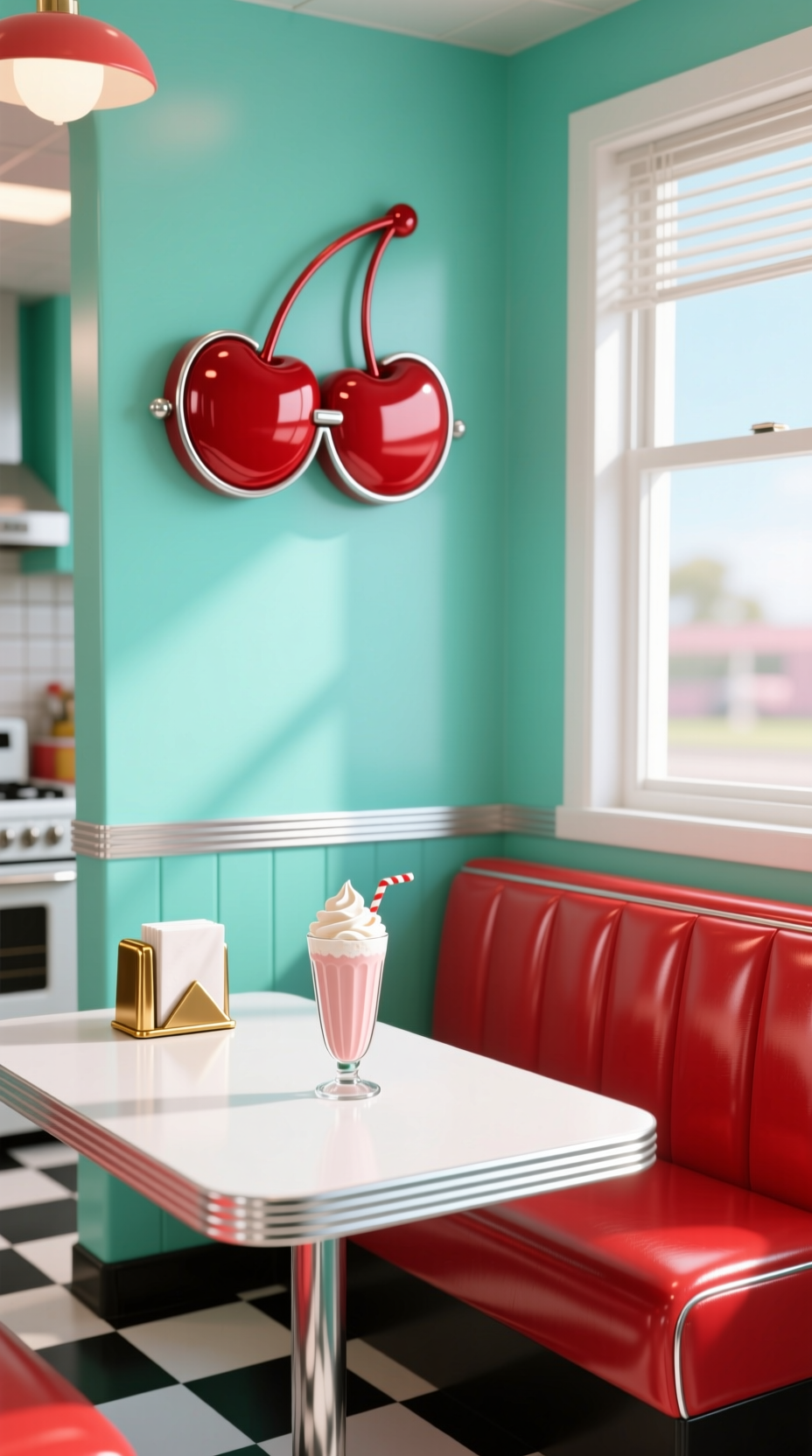
Pin this fun retro idea to your ‘Dream Kitchen’ board!
Materials Needed:
- One large, high-quality retro metal tin sign (look for themes like “Coffee,” “EAT,” or classic soda brands)
- Picture hanging kit with nails suitable for your wall type (drywall, plaster)
- Laser level or level app on your phone
- Tape measure and pencil
- Optional: Small, complementary decor like a retro napkin dispenser or salt and pepper shakers
Step-by-Step Directions:
- Choose Your Corner: Identify a breakfast nook or a small, underutilized wall that can serve as a focal point.
- Position the Sign: Hold the sign against the wall to determine the best height. A good rule is to center it at eye level (around 57 inches from the floor) or center it relative to your nook furniture.
- Mark Your Spot: Use the tape measure and pencil to lightly mark where the top of the sign will go. Use the level to ensure your mark is perfectly straight.
- Install the Hanger: Following the instructions on your hanging kit, install the nail or hook.
- Hang and Style: Hang your retro sign. Complete the look by placing your complementary decor on the table below.
Pro-Tip: For a truly authentic look, choose a sign with embossed lettering. The raised texture catches the light and makes the sign look more substantial and genuinely vintage.
2. Install a Warm Rustic Farmhouse Welcome Wall

Save this charming farmhouse idea for your kitchen!
Materials Needed:
- One large, framed wood sign with a welcoming phrase (e.g., “Gather,” “Kitchen,” or “Blessed”). Look for a sign with a dark-stained frame and a white background.
- Heavy-duty wall anchors and screws (essential for large, heavy signs)
- Stud finder
- Power drill
- Level, tape measure, and pencil
Step-by-Step Directions:
- Find the Studs: Use the stud finder to locate the wall studs in the area where you want to hang the sign. This is the most secure place to anchor it. Mark the stud locations with a pencil.
- Measure and Mark: Center the sign on your chosen wall. Measure the distance between the hanging brackets on the back of the sign. Transfer these measurements to the wall, ensuring your marks are level and align with the studs if possible.
- Drill and Anchor: Drill pilot holes on your marks. If you’re not drilling into a stud, gently tap your wall anchors into the holes until they are flush with the wall.
- Secure the Screws: Drill the screws into the anchors (or directly into the studs), leaving them protruding about 1/4 inch from the wall.
- Hang Your Sign: Carefully lift and hang your sign onto the secured screws. Double-check that it’s level.
Lesson Learned: Don’t skip the stud finder! A large wooden sign can be heavy, and relying on drywall alone is a recipe for disaster. Security is just as important as style.
3. Arrange a Classic Botanical Illustration Set

Pin this timeless botanical art idea!
Materials Needed:
- A set of 4 to 6 matching vintage botanical prints (herb, fruit, or vegetable themes work well). Ensure they are printed on high-quality, archival-quality matte paper.
- Simple, identical frames for each print (thin black, natural wood, or antique gold frames are great choices).
- Painter’s tape
- Level, tape measure, and pencil
- Picture hanging nails
Step-by-Step Directions:
- Frame Your Prints: Carefully place each print into its frame, ensuring it’s centered and free of dust.
- Plan Your Grid: Lay the framed prints on the floor to decide on your arrangement. A 2×2 or 2×3 grid is a classic choice.
- Measure Your Spacing: Decide on the spacing between your frames. A consistent 2-3 inches is standard and looks clean.
- Create a Template (Optional but recommended): Trace your frames onto paper and tape the paper cutouts to the wall. This allows you to perfect the layout without making any nail holes.
- Hang the First Frame: Start with the top-left frame. Measure and mark for the nail, then hang it.
- Build the Grid: Use your level and tape measure to hang the remaining frames, maintaining your consistent spacing. Work from top to bottom, left to right.
Pro-Tip: For a high-end look, choose prints with an off-white, cream-colored background rather than stark white. It enhances the vintage feel and looks softer on the wall.
4. Design a Cozy Vintage Coffee Bar Nook

Save this cozy coffee corner inspiration!
Materials Needed:
- One small to medium-sized vintage coffee-themed art piece (a gallery-wrapped canvas print is great here as it’s durable and needs no frame).
- Your coffee maker and accessories (mugs, coffee bean container, etc.).
- Optional: A small tray to ground the items on the counter.
- Small sawtooth hanger and nail.
- Level and pencil.
Step-by-Step Directions:
- Define Your Zone: Designate a small section of your countertop as your coffee station. Place your coffee maker there.
- Arrange Your Items: Group your mugs, beans, and other accessories around the coffee maker. Using a tray can make the setup look more organized and intentional.
- Position Your Art: The art should be centered above your coffee station. The bottom of the canvas should be 4-6 inches above the top of your coffee maker to give it breathing room.
- Mark and Hang: Hold the canvas in place and make a light pencil mark on the wall at the top center. Install your nail slightly below this mark and hang your art.
- Final Touches: Step back and adjust your countertop items until the entire nook feels balanced and inviting.
Lesson Learned: The art is what elevates a simple coffee station into a styled “nook.” Don’t hang it too high; it needs to feel connected to the items on the counter below it.
5. Curate an Eclectic Vintage Gallery Wall
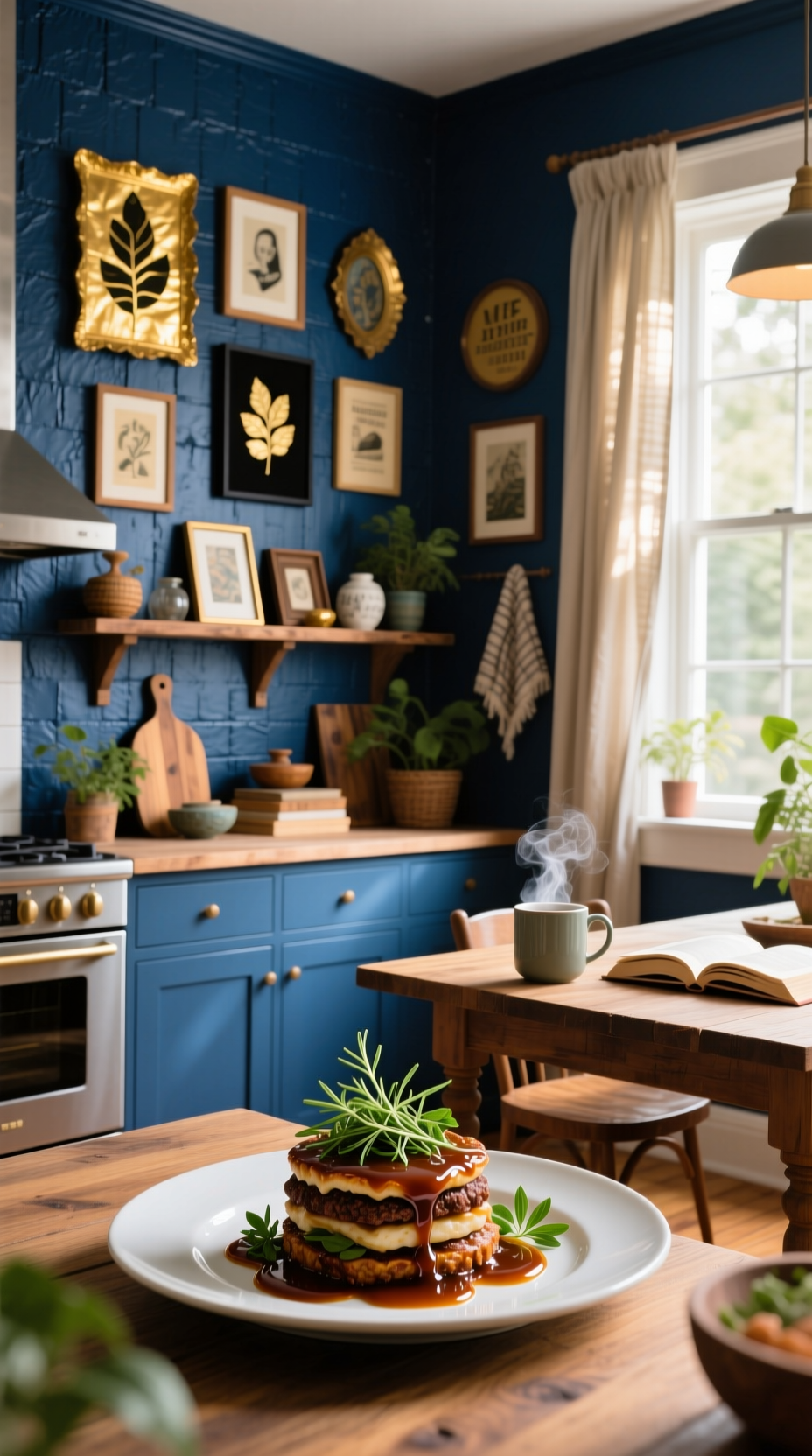
Pin this guide to creating the perfect gallery wall!
Materials Needed:
- A collection of 5-7 vintage-style art pieces in various sizes.
- A mix of frames (e.g., gold, black, wood) for an eclectic look.
- One larger “anchor” piece to build the arrangement around.
- Kraft paper or newspaper, scissors, and painter’s tape.
- Hanging hardware, hammer, level, tape measure.
Step-by-Step Directions:
- Find a Unifying Element: To keep the look cohesive, choose a common thread. This could be a consistent color (like a touch of blue in each piece), a common theme (like nature), or a single frame color mixed with others.
- Create Paper Templates: Trace each of your framed pieces onto kraft paper and cut them out.
- Plan on the Floor: Arrange the actual framed pieces on the floor until you have a layout you love. Start with your largest anchor piece off-center, then build around it. Aim for consistent 2-3 inch spacing.
- Transfer to the Wall: Recreate your floor layout on the wall using your paper templates and painter’s tape. This is your chance to make adjustments without creating nail holes.
- Hang Your Art: Once you’re happy with the paper layout, install a nail for each piece directly through the paper template where the hanger should be. Then, tear the paper away and hang your art.
Pro-Tip: Include one non-rectangular item in your gallery wall, like a small round mirror or a vintage decorative plate. This breaks up the grid and adds a professional, designer touch.
6. Add a Sleek Mid-Century Modern Print
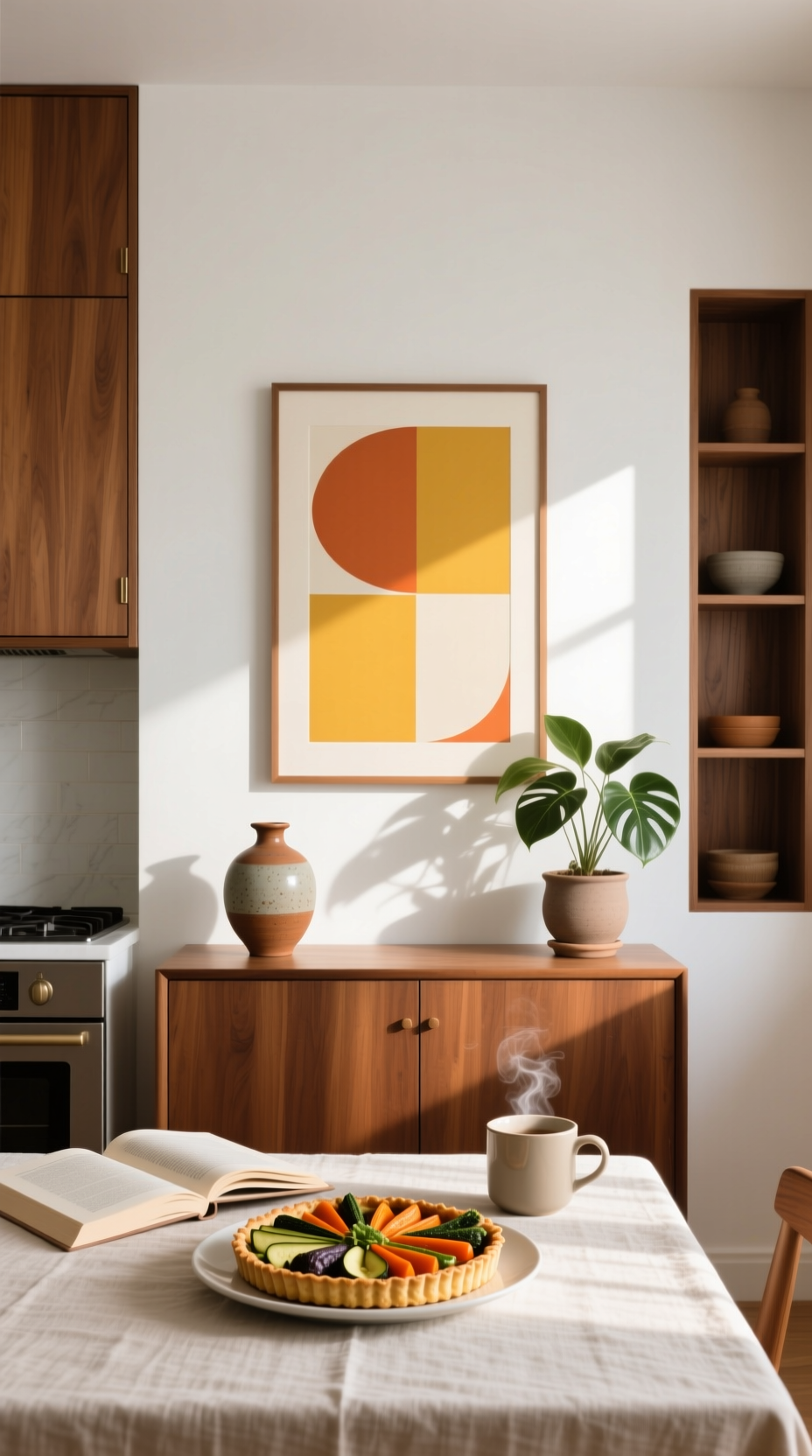
Save this chic mid-century modern look!
Materials Needed:
- One large (24×36 inches or larger) mid-century modern style art print. Look for designs with geometric shapes, starbursts, or abstract forms.
- A simple, high-quality frame with a thin profile. Natural teak, walnut, or a simple black frame works best.
- Heavy-duty picture hanging wire kit.
- Two heavy-duty picture hooks and nails.
- Level, tape measure, pencil, and drill.
Step-by-Step Directions:
- Attach the Wire: Install the D-rings from your wire kit onto the back of the frame, about one-third of the way down from the top on each side. String the picture wire between them, leaving a little bit of slack but keeping it taut.
- Determine Placement: This style looks best as a single, bold statement piece. Center it on a prominent wall. The center of the art should be at eye level (57-60 inches).
- Mark for Hooks: Hold the art against the wall at the desired height. Use a pencil to lightly mark the top center of the frame. Measure down from that mark to where the taut wire will be, and this is where your hooks will go. Use a level to mark the positions for two hooks, spaced about 8-12 inches apart.
- Install Hooks: Securely install your two heavy-duty hooks on the marks. Using two hooks provides more stability for a large piece and helps it stay level.
- Hang and Adjust: Carefully hang the wire onto the two hooks. Use your level to make final adjustments.
Pro-Tip: Let the art be the star. Keep the surrounding wall and surfaces relatively uncluttered to maximize the impact of the clean, graphic print.
7. Display Sentimental Vintage Recipe Art
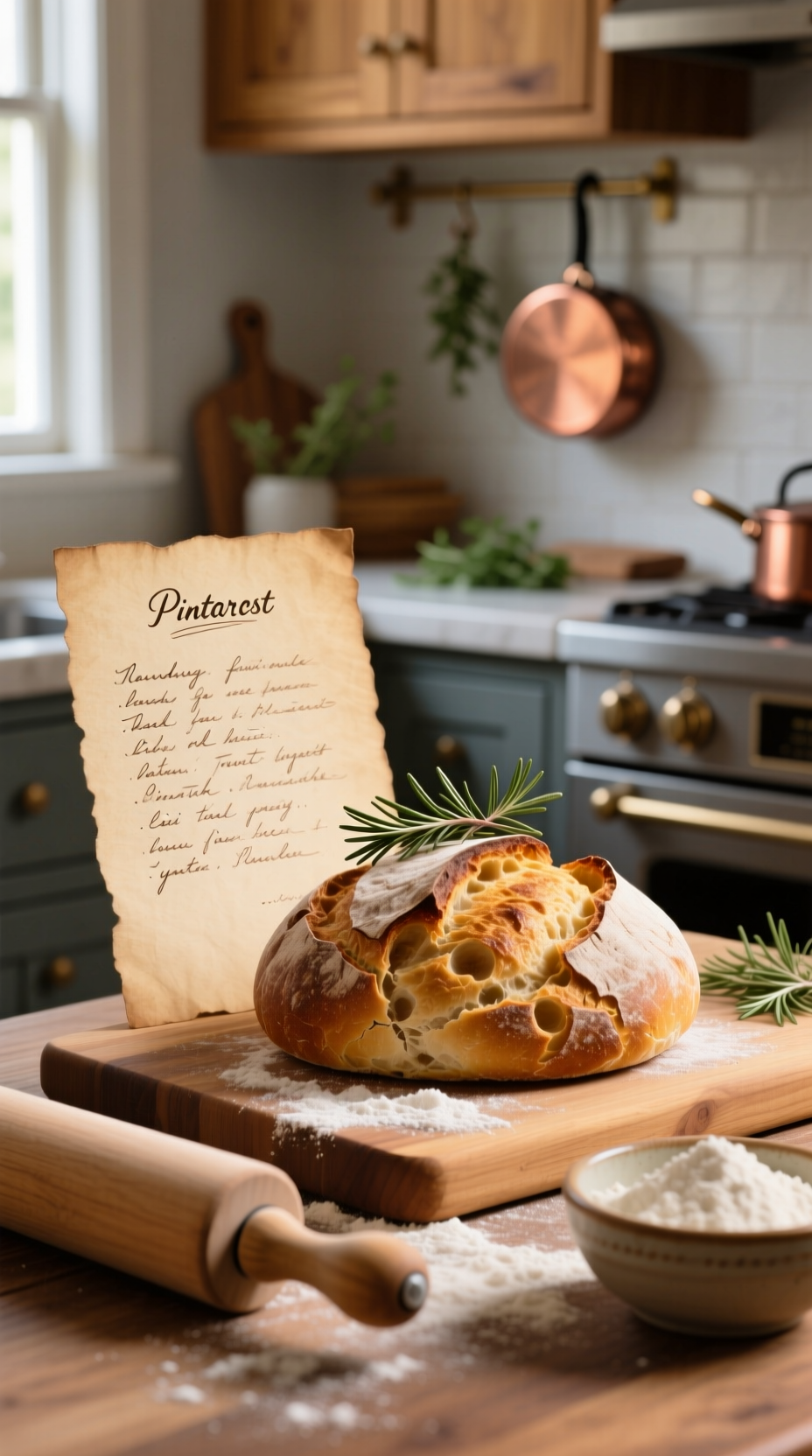
Pin this heartfelt and personal decor idea!
Materials Needed:
- A high-resolution scan or photograph of a cherished family recipe card.
- A service that prints custom art on canvas or archival paper.
- A simple, elegant frame that complements the style of the recipe card.
- Picture hanging kit.
Step-by-Step Directions:
- Digitize Your Recipe: Scan your family recipe card at a high resolution (at least 300 DPI) or take a clear, well-lit photo of it from directly above.
- Minor Edits (Optional): Use a simple photo editing tool to crop the image, adjust the brightness, and enhance the contrast to make the handwriting pop.
- Choose a Print Service: Find a reputable online printing service that allows you to upload your own image to be printed on your choice of material (giclée paper print or canvas are excellent choices).
- Order Your Print: Upload your digitized recipe file, select the size and material, and place your order.
- Frame and Hang: Once your custom print arrives, frame it beautifully. Hang it in a special spot in your kitchen, like near your baking station, where it can be appreciated every day.
Lesson Learned: Don’t just frame the original! The kitchen environment can be harsh. By printing a high-quality copy, you can display the memory while safely preserving the precious original heirloom.
8. Add an Earthy 70s Boho Accent
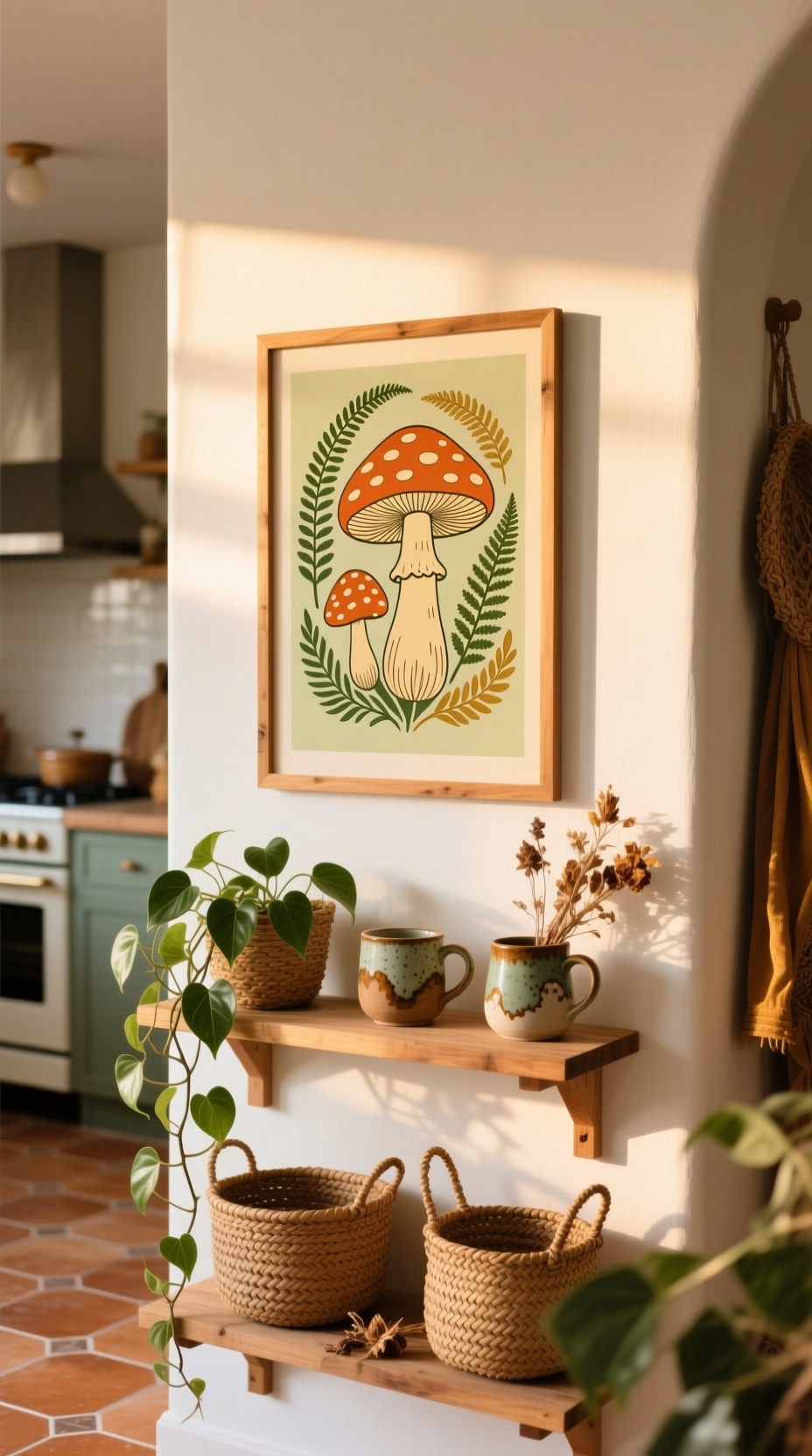
Save this groovy 70s decor idea!
Materials Needed:
- One or two 70s-inspired art prints. Look for motifs like stylized suns, mushrooms, ferns, or bold floral patterns.
- Simple, natural wood frames or poster hangers.
- Hanging hardware appropriate for your choice of frame.
- Level, pencil, tape measure.
Step-by-Step Directions:
- Choose Your Vibe: Decide if you want a single statement piece or a complementary pair of prints.
- Frame Simply: The 70s boho style is all about natural materials. A simple light wood frame or a magnetic wood poster hanger enhances the earthy feel without overwhelming the art.
- Integrate with Plants: This style pairs perfectly with houseplants. Plan to hang your art near open shelving with trailing plants or next to a sunny window with a hanging planter.
- Hang and Arrange: Hang your print(s) using standard methods. Then, arrange your plants and other natural-textured decor (like macrame or ceramics) around it to create a cohesive, layered look.
Pro-Tip: The key to modernizing the 70s look is to use the iconic colors and patterns as accents within a more neutral space. Let the art be your pop of harvest gold or burnt orange against a white or cream wall.
9. Evoke a Chic French Bistro Scene
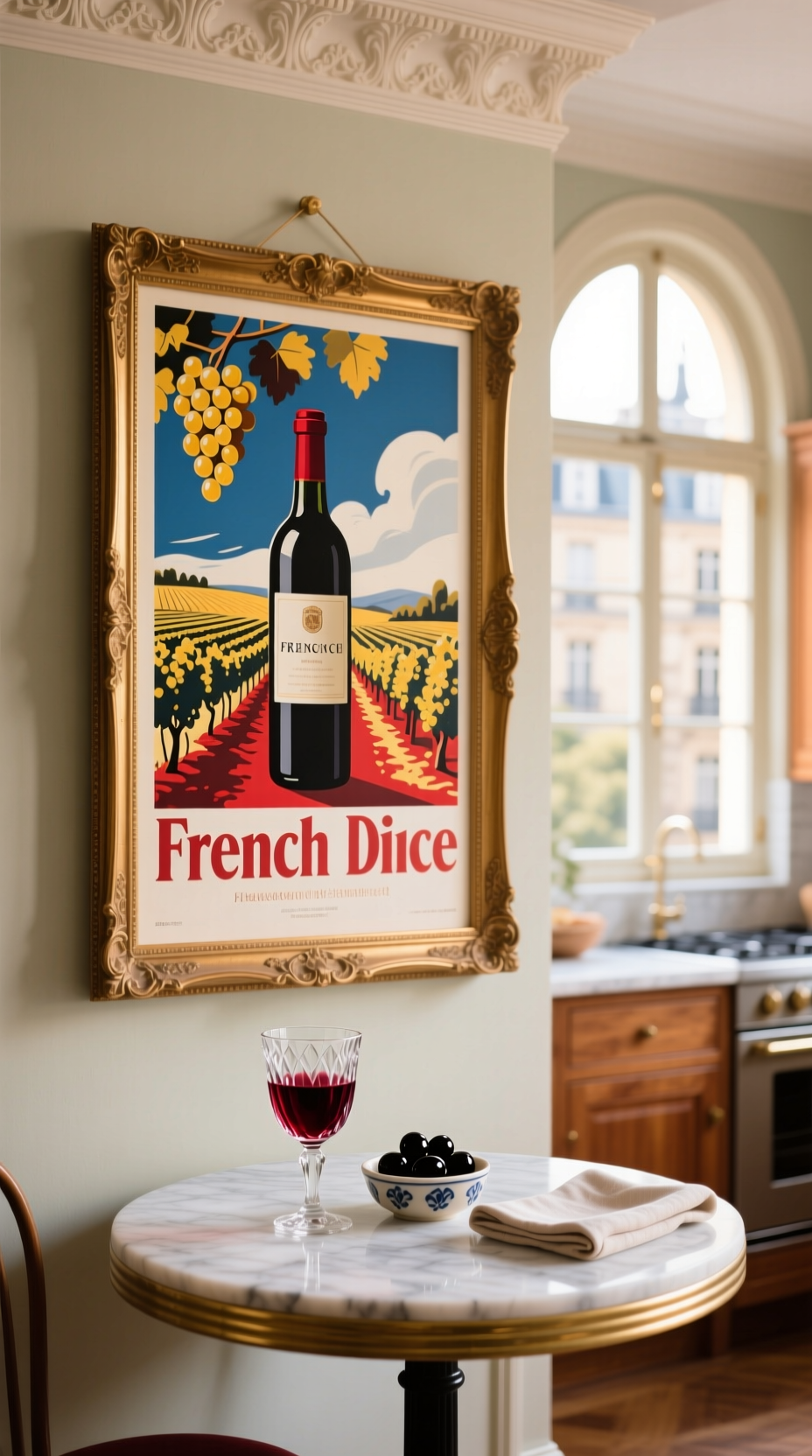
Pin this chic Parisian kitchen idea!
Materials Needed:
- One large vintage European advertisement poster print. Classic French wine, aperitif, or food brands are iconic choices.
- An elegant frame. A slightly ornate gold or detailed black frame works beautifully to elevate the poster. Consider one with a mat to give it a more formal look.
- Hanging hardware suitable for a large, potentially heavy frame (wire kit and two hooks recommended).
- Level, tape measure, pencil.
Step-by-Step Directions:
- Choose Your Icon: Select a poster that speaks to you. The artwork from the Art Nouveau period is particularly popular for this style and adds an instant touch of elegance.
- Invest in the Frame: For this look, the frame is as important as the print. Choose a frame that feels substantial and classic. Professional framing is a great option if it’s in your budget.
- Find the Right Wall: This piece works wonderfully as a focal point above a small dining table, a bar cart, or a standalone statement on a prominent kitchen wall.
- Hang with Precision: Follow the two-hook wire hanging method described in the Mid-Century Modern idea (Idea #6). This ensures your large, elegant piece remains perfectly level and secure.
Pro-Tip: Group this art with other bistro-inspired elements like a marble utensil holder, a small chalkboard for menus, or a hanging pot rack to fully capture the charming cafe aesthetic.
Key Takeaways: Your Quick Guide to a Charming Vintage Kitchen
- Find Your Vibe: Choose a specific style—like 50s Diner, Modern Farmhouse, or 70s Boho—to give your decor a cohesive look.
- Mind the Scale: Ensure your art is properly sized for your wall. A good rule of thumb is to fill two-thirds of the empty space.
- Hang at Eye Level: The center of your art should be around 57 inches from the floor to feel connected to the room.
- Mix, Don’t Match (for Gallery Walls): For an eclectic look, mix frame styles and art sizes, but keep a common element like a color or theme.
- Personalize It: The most charming decor tells a story. Consider a custom piece, like a framed family recipe, to make your kitchen truly unique.
FAQs About kitchen wall decor vintage
What’s the difference between vintage and retro kitchen decor?
Vintage technically refers to an item that is actually old (20-99 years), while retro describes a new item made to imitate a style from the past. In online shopping, however, the terms are often used interchangeably to mean a nostalgic, non-modern style. Think of “retro” as a style and “vintage” as an age.
What kind of art is durable enough for a kitchen?
Gallery-wrapped canvas prints and metal tin signs are the most durable options for a kitchen environment. They can withstand humidity better than paper and are easy to wipe clean. If you use paper prints, ensure they are protected behind glass in a quality frame to shield them from moisture and grease.
How do I choose the right size art for above my kitchen table?
Your artwork should be approximately two-thirds the width of your kitchen table. This creates a balanced look where the art is proportionate to the furniture beneath it. For example, if your table is 60 inches wide, aim for art that is around 40 inches wide.
Should all the frames in a kitchen gallery wall match?
No, they don’t have to match! For a more curated and eclectic look, mixing frame materials like wood, gold, and black is highly recommended. To keep it from looking chaotic, find another unifying element, like a consistent color in each art piece or a common theme.
Final Thoughts
Decorating your kitchen with vintage art isn’t about following strict rules; it’s about creating a space that reflects your personality and feels like home. The goal is to choose artwork that brings you joy every time you see it. Whether it’s a bold retro advertisement or a sentimental family recipe, the right piece can completely transform the ambiance of your room.
Don’t feel pressured to do everything at once. Simply choose the one idea from this list that sparked the most excitement and start there. You’ll be amazed at how a single piece of art can make your kitchen feel more charming and full of character.
What vintage style are you most excited to bring into your kitchen? Let us know in the comments below
Last update on 2025-12-14 at 01:08 / Affiliate links / Images from Amazon Product Advertising API
